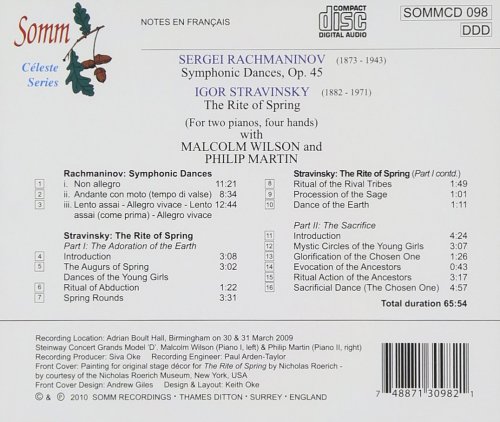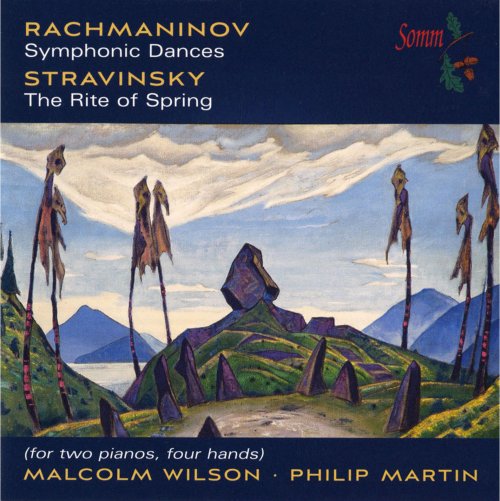
Philip Martin, Malcolm Wilson - Rachmaninov: Symphonic Dances - Stravinsky: The Rite of Spring (2014)
BAND/ARTIST: Philip Martin, Malcolm Wilson
- Title: Rachmaninov: Symphonic Dances - Stravinsky: The Rite of Spring
- Year Of Release: 2014
- Label: SOMM Recordings
- Genre: Classical Piano
- Quality: flac lossless +Booklet
- Total Time: 01:05:53
- Total Size: 218 mb
- WebSite: Album Preview
Tracklist
01. Symphonic Dances, Op. 45: I. Non allegro
02. Symphonic Dances, Op. 45: II. Andante con moto (Tempo di valse)
03. Symphonic Dances, Op. 45: III. Lento assai - Allegro vivace
04. The Rite of Spring, Pt. I. Adoration of the Earth: Introduction
05. The Rite of Spring, Pt. I. Adoration of the Earth: The Augurs of Spring - Dances of the Young Girls
06. The Rite of Spring, Pt. I. Adoration of the Earth: Ritual of Abduction
07. The Rite of Spring, Pt. I. Adoration of the Earth: Spring Rounds
08. The Rite of Spring, Pt. I. Adoration of the Earth: Ritual of the River Tribes
09. The Rite of Spring, Pt. I. Adoration of the Earth: Procession of the Sage
10. The Rite of Spring, Pt. I. Adoration of the Earth: Dance of the Earth
11. The Rite of Spring, Pt. II. The Sacrifice: Introduction
12. The Rite of Spring, Pt. II. The Sacrifice: Mystic Circles of the Young Girls
13. The Rite of Spring, Pt. II. The Sacrifice: Glorification of the Chosen One
14. The Rite of Spring, Pt. II. The Sacrifice: Evocation of the Ancestors
15. The Rite of Spring, Pt. II. The Sacrifice: Ritual Action of the Ancestors
16. The Rite of Spring, Pt. II. The Sacrifice: Sacrificial Dance

The Symphonic Dances were arranged for two pianos by Rachmaninov, concurrently with the orchestral version premiered by Ormandy and the Philadelphia Orchestra in 1941. He performed this version privately for a few friends at his Long Island home with Vladimir Horowitz, and which surely would have been heard in public played by these two virtuosi had not the composer’s death intervened.
Stravinsky’s piano-duet arrangement of his notorious ballet Le Sacre du Printemps was probably provoked by the difficulties encountered in dance-rehearsals. Marie Rambert, a member of the original company at the premiere in 1913, remembered how during a rehearsal of the gruelling Danse Sacrale, “hearing the way the music was being played, Stravinsky blazed up, pushed aside the fat German pianist… and proceeded to play twice as fast as we had been doing it, and twice as fast as we could possibly dance. He stamped his feet on the floor and banged his fist on the piano and sang and shouted…”
The Symphonic Dances were Rachmaninov’s last completed composition, written during the summer of 1940 when the composer was recuperating after a minor operation. Perhaps because of the circumstances, the work adds retrospection to Rachmaninov’s customary recourse to Russian Orthodox chant, the Dies Irae in particular, and the result is extraordinarily moving.
The two-piano version robs us of the effect contributed by an incisive piano to the orchestral version (its initial entry soon after the opening creates a whole new sinister sound-world), but gives us instead a concentration upon detail and rhythmic impetus which the seductions of Rachmaninov’s orchestral colourings might veil. This is a tightly-wrought structure, with thematic integration at its heart, and hearing it in such a pared-down texture brings these qualities to the fore.
More prominent than this, though, are the thematic quotations: the Dies Irae in the first movement, alongside poignantly, the motto-theme from Rachmaninov’s student First Symphony, ruined at its premiere by the conducting of the allegedly drunken Glazunov, leading to a breakdown in the young composer and suppression of the work until after his death; then, after the haunted ballroom which is the middle movement, the reappearance of the Dies Irae to permeate the grim finale, a genuine dance of death, where Rachmaninov also recalls the chant “Blagosloven esi, Gospodi” (‘Blessed be the Lord’) from the wonderful Vespers of 1915.
Famously percussive, Le Sacre is well-suited to the timbres and articulations of the piano, and so many of the chordal combinations sit so comfortably under the hand — of the composer as he completed the work in Clarens in Switzerland, and of the executants as they perform this viscerally exciting transcription: the chugging repeated chords of Harbingers of Spring, the measured, hypnotic strumming of the Introduction to Part II, and so much else.
There are elements in Stravinsky’s orchestral score which are rarely heard in performance, not least in the wild Dance of the Earth which ends Part I. In this four-hand transcription, sensibly divided between two pianos, more of that detail comes through. And an added bonus is the fact that two pianists can approach closer to the composer’s intended speeds than most orchestras and conductors ever try to do”. (Excerpts from CD liner notes, with permission from Christopher Morley)
Malcolm Wilson and Philip Martin began playing as a piano duo in the 1980’s in Birmingham Conservatoire where they were both teaching. They found an immediate musical rapport and began to give recitals together. Their duo repertoire is wide, and, in addition to the standard works, they have given many first performances both in the UK and abroad, particularly in France and Italy.
They also pursue their own individual careers as solo pianists and chamber music players. Malcolm is the principal pianist with the acclaimed Birmingham Contemporary Music Group and has made many recordings and television documentaries with both them and the City of Birmingham Symphony Orchestra.
Philip is a renowned composer, soloist with many British orchestras, and well-known for his many broadcasts and recordings for Hyperion records. On this, their first CD together for SOMM, they have chosen to present these works by Rachmaninov and Stravinsky, which have featured prominently in their repertoire for the last decade and for which they both feel a particular affinity and affection.
01. Symphonic Dances, Op. 45: I. Non allegro
02. Symphonic Dances, Op. 45: II. Andante con moto (Tempo di valse)
03. Symphonic Dances, Op. 45: III. Lento assai - Allegro vivace
04. The Rite of Spring, Pt. I. Adoration of the Earth: Introduction
05. The Rite of Spring, Pt. I. Adoration of the Earth: The Augurs of Spring - Dances of the Young Girls
06. The Rite of Spring, Pt. I. Adoration of the Earth: Ritual of Abduction
07. The Rite of Spring, Pt. I. Adoration of the Earth: Spring Rounds
08. The Rite of Spring, Pt. I. Adoration of the Earth: Ritual of the River Tribes
09. The Rite of Spring, Pt. I. Adoration of the Earth: Procession of the Sage
10. The Rite of Spring, Pt. I. Adoration of the Earth: Dance of the Earth
11. The Rite of Spring, Pt. II. The Sacrifice: Introduction
12. The Rite of Spring, Pt. II. The Sacrifice: Mystic Circles of the Young Girls
13. The Rite of Spring, Pt. II. The Sacrifice: Glorification of the Chosen One
14. The Rite of Spring, Pt. II. The Sacrifice: Evocation of the Ancestors
15. The Rite of Spring, Pt. II. The Sacrifice: Ritual Action of the Ancestors
16. The Rite of Spring, Pt. II. The Sacrifice: Sacrificial Dance

The Symphonic Dances were arranged for two pianos by Rachmaninov, concurrently with the orchestral version premiered by Ormandy and the Philadelphia Orchestra in 1941. He performed this version privately for a few friends at his Long Island home with Vladimir Horowitz, and which surely would have been heard in public played by these two virtuosi had not the composer’s death intervened.
Stravinsky’s piano-duet arrangement of his notorious ballet Le Sacre du Printemps was probably provoked by the difficulties encountered in dance-rehearsals. Marie Rambert, a member of the original company at the premiere in 1913, remembered how during a rehearsal of the gruelling Danse Sacrale, “hearing the way the music was being played, Stravinsky blazed up, pushed aside the fat German pianist… and proceeded to play twice as fast as we had been doing it, and twice as fast as we could possibly dance. He stamped his feet on the floor and banged his fist on the piano and sang and shouted…”
The Symphonic Dances were Rachmaninov’s last completed composition, written during the summer of 1940 when the composer was recuperating after a minor operation. Perhaps because of the circumstances, the work adds retrospection to Rachmaninov’s customary recourse to Russian Orthodox chant, the Dies Irae in particular, and the result is extraordinarily moving.
The two-piano version robs us of the effect contributed by an incisive piano to the orchestral version (its initial entry soon after the opening creates a whole new sinister sound-world), but gives us instead a concentration upon detail and rhythmic impetus which the seductions of Rachmaninov’s orchestral colourings might veil. This is a tightly-wrought structure, with thematic integration at its heart, and hearing it in such a pared-down texture brings these qualities to the fore.
More prominent than this, though, are the thematic quotations: the Dies Irae in the first movement, alongside poignantly, the motto-theme from Rachmaninov’s student First Symphony, ruined at its premiere by the conducting of the allegedly drunken Glazunov, leading to a breakdown in the young composer and suppression of the work until after his death; then, after the haunted ballroom which is the middle movement, the reappearance of the Dies Irae to permeate the grim finale, a genuine dance of death, where Rachmaninov also recalls the chant “Blagosloven esi, Gospodi” (‘Blessed be the Lord’) from the wonderful Vespers of 1915.
Famously percussive, Le Sacre is well-suited to the timbres and articulations of the piano, and so many of the chordal combinations sit so comfortably under the hand — of the composer as he completed the work in Clarens in Switzerland, and of the executants as they perform this viscerally exciting transcription: the chugging repeated chords of Harbingers of Spring, the measured, hypnotic strumming of the Introduction to Part II, and so much else.
There are elements in Stravinsky’s orchestral score which are rarely heard in performance, not least in the wild Dance of the Earth which ends Part I. In this four-hand transcription, sensibly divided between two pianos, more of that detail comes through. And an added bonus is the fact that two pianists can approach closer to the composer’s intended speeds than most orchestras and conductors ever try to do”. (Excerpts from CD liner notes, with permission from Christopher Morley)
Malcolm Wilson and Philip Martin began playing as a piano duo in the 1980’s in Birmingham Conservatoire where they were both teaching. They found an immediate musical rapport and began to give recitals together. Their duo repertoire is wide, and, in addition to the standard works, they have given many first performances both in the UK and abroad, particularly in France and Italy.
They also pursue their own individual careers as solo pianists and chamber music players. Malcolm is the principal pianist with the acclaimed Birmingham Contemporary Music Group and has made many recordings and television documentaries with both them and the City of Birmingham Symphony Orchestra.
Philip is a renowned composer, soloist with many British orchestras, and well-known for his many broadcasts and recordings for Hyperion records. On this, their first CD together for SOMM, they have chosen to present these works by Rachmaninov and Stravinsky, which have featured prominently in their repertoire for the last decade and for which they both feel a particular affinity and affection.
As a ISRA.CLOUD's PREMIUM member you will have the following benefits:
- Unlimited high speed downloads
- Download directly without waiting time
- Unlimited parallel downloads
- Support for download accelerators
- No advertising
- Resume broken downloads


